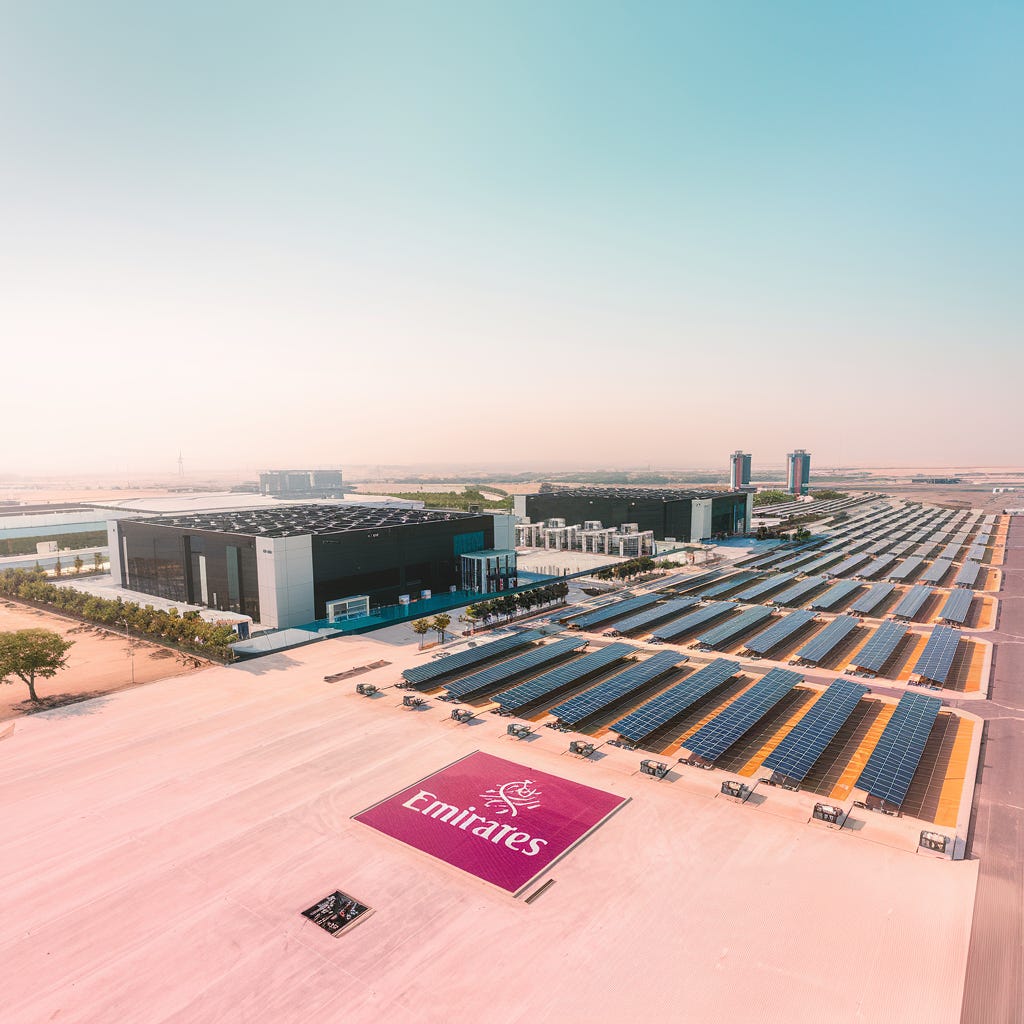How Emirates Will Power Its Digital Operations with 3GW of Clean Energy (Without Building a Data Center)
Emirates is relocating its data center operations to the world’s largest solar-powered data center, without building its own.
You received this email because you subscribed to Global Data Center Hub, a newsletter about the global data center sector.
Thank you very much for supporting my newsletter this month. Your readership encourages me to provide these insights, and I’m truly grateful for it.
We publish new insights seven days a week, helping you stay ahead of the most important shifts in data centers, AI infrastructure, and global connectivity.
Our premium insights are reserved for paid subscribers.
If you haven’t upgraded yet, now’s a great time:
👉 Subscribe and join hundreds of readers of “Global Data Center Hub” with a 20% discount on the annual plan: Subscribe here
The Emirates Group, one of the world’s most recognized aviation brands, has taken a landmark step in its sustainability strategy.
But instead of building new infrastructure from scratch, it opted for something smarter:
Partnering with Moro Hub to co-locate its data operations inside the world’s largest solar-powered data center.
Located within Dubai’s Mohammad Bin Rashid Al Maktoum Solar Park, the facility is already Guinness-certified and represents a new global standard for green hyperscale infrastructure.
The move is a masterclass in how enterprises can decarbonize digital operations without owning or building massive facilities.
Let’s unpack what this means and why it matters.
What’s Happening
On March 26, 2025, Emirates and Moro Hub (a subsidiary of Digital DEWA) signed a co-location agreement that will see Emirates’ data center operations transferred to Moro Hub’s flagship facility beginning mid-2026.
This includes a full suite of infrastructure services:
Rack space
Power and cooling
Equipment provisioning
Resilience and scalability upgrades
Importantly, the facility is powered entirely by renewable energy from the surrounding solar park, projected to supply Emirates with around 3,000 MWh of clean energy per year for its IT operations.
Why This Is Strategic
This partnership isn’t just about location or energy, it’s about alignment.
It links:
National clean energy strategy (Dubai Clean Energy Strategy 2050)
Enterprise-scale digital transformation (Emirates’ tech and data evolution)
Global sustainability signaling (ESG positioning in aviation and infrastructure)
The Middle East is rapidly becoming a testbed for this kind of convergence.
Rather than siloing data centers as purely technical assets, players like Emirates are recognizing them as carbon levers and brand assets. By using existing capacity in a solar-powered facility, they’ve achieved three things simultaneously:
Reduced capital intensity
Immediate ESG gains
Strengthened alignment with national vision
The Facility: Moro Hub’s Record-Breaking Site
Location: Mohammad Bin Rashid Al Maktoum Solar Park
Size: Targeting 100MW across multiple phases
Current Status: Initial 6.5MW phase operational since 2023
Power Source: 100% solar, drawn from the adjacent 3GW solar park
Technology Partners: Huawei, Microsoft, Dell, VMware
This is not just a hyperscale build, it’s a flagship example of clean digital infrastructure at scale.
Moro Hub has been explicit in its mission to offer world-class cloud, colocation, and cybersecurity services anchored in sustainability. Emirates is now its highest-profile enterprise client.
Broader Implications
What we’re seeing here is the emergence of a new model for enterprise IT infrastructure:
Clean Infrastructure-as-a-Service.
Rather than building proprietary facilities, enterprises will increasingly partner with energy-aligned data center operators to accelerate their decarbonization and digitization goals.
This model:
Lowers deployment risk
Reduces Scope 2 emissions immediately
Offers enterprise-grade resilience with sustainability credentials
Integrates seamlessly with cloud and hybrid strategies
The Emirates–Moro Hub deal is a signal that this model is ready for scale.
What Comes Next?
Expect to see:
More enterprise moves toward co-location in green facilities
Greater alignment between public utilities and digital infrastructure developers
Increased focus on Scope 2 emissions from IT operations
Broader adoption of green infrastructure in non-tech industries (aviation, manufacturing, logistics)
In the long term, this model could redefine how we think about corporate digital infrastructure. Not as isolated server rooms or leased racks, but as core components of climate strategy, brand trust, and operational resilience.
Final Take
Emirates didn’t just move data.
It moved the needle.
By choosing to co-locate in the world’s largest solar-powered data center,
it aligned itself with a smarter, faster, and cleaner future—without breaking ground or burning capital.
This is the playbook for large enterprises in the age of climate accountability.
And it’s one more reason why the digital infrastructure sector must now be seen not only through the lens of performance and uptime—but through the lens of emissions, ecosystem alignment, and global impact.
The future isn’t just faster. It’s cleaner.
And in Dubai, it’s already here.
One More Thing
I publish daily on data center investing, AI infrastructure, and the trends reshaping global data center markets.
Join 900+ investors, operators, and innovators getting fresh insights every day and upgrade anytime to unlock premium research trusted by leading investors and developers.

